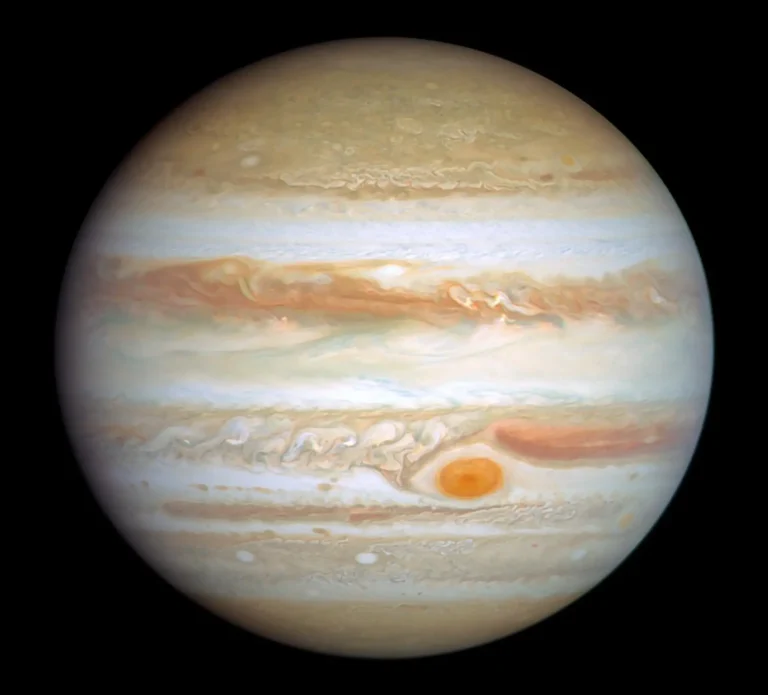Is Jupiter a Failed Star?
Jupiter, the largest planet in our solar system, is often called a “failed star.” But is there any truth to this nickname? Let’s explore the science behind this fascinating claim and understand what truly separates a planet like Jupiter from a star like our Sun.

What Does "Failed Star" Mean?
The term “failed star” refers to celestial objects that are too large to be planets, yet too small to sustain nuclear fusion — the process that powers stars. These objects are called brown dwarfs. Jupiter shares some characteristics with brown dwarfs, leading to the comparison.
But is Jupiter truly a brown dwarf — or just a massive gas giant?
Why Jupiter Isn’t a Star?
To become a star, an object must undergo nuclear fusion, where hydrogen atoms fuse into helium under extreme pressure and temperature. This process releases the energy that makes stars shine.
Here’s why Jupiter doesn’t qualify:
- Jupiter’s mass is about 1/1000th of the Sun’s.
- It would need to be at least 80 times more massive to initiate fusion and become a true star.
- Its core temperature and internal pressure aren’t high enough for fusion to occur.
So, while Jupiter is made mostly of hydrogen and helium, like a star, it lacks the mass needed to ignite.
Jupiter vs. Brown Dwarfs
Brown dwarfs are often called “substellar objects.” They’re in the middle ground between planets and stars. While they don’t burn hydrogen like true stars, some brown dwarfs can fuse deuterium, a heavier form of hydrogen.
Here’s how Jupiter compares to a brown dwarf:
- Mass:
- Jupiter has 1 Jupiter mass (1 MJ).
- Brown dwarfs typically range from 13 to 80 Jupiter masses (MJ).
- Fusion Capability:
- Jupiter: Cannot fuse any elements.
- Brown Dwarfs: Can fuse deuterium (a heavier form of hydrogen) if they are massive enough.
- Light Emission:
- Jupiter: Does not emit visible light; it reflects sunlight and emits faint infrared radiation.
- Brown Dwarfs: Emit a faint glow, especially in the infrared spectrum.
- Classification:
- Jupiter: A gas giant planet.
- Brown Dwarf: A substellar object, often called a “failed star”.
So, while Jupiter is made mostly of hydrogen and helium, like a star, it lacks the mass needed to ignite.
Why People Call Jupiter a "Failed Star"?
People often call Jupiter a failed star because:
- Its composition (mostly hydrogen and helium) is similar to the Sun’s.
- It gives off more heat than it receives from the Sun — suggesting internal energy.
- It’s immense in size, over 300 times more massive than Earth.
However, this is more poetic than scientific. Jupiter simply never had a chance to become a star — it didn’t gather enough mass during formation.
The Role of Jupiter in the Solar System
Even though it’s not a star, Jupiter plays a crucial role in our solar system:
- Its gravity has shaped the orbits of other planets.
- It protects Earth by deflecting comets and asteroids.
- Jupiter’s moons (like Europa and Ganymede) are key targets in the search for extraterrestrial life.
Jupiter might not shine like the Sun, but it’s still a giant protector and influencer of the solar system.
FAQs About Jupiter Being a Failed Star
Is Jupiter a brown dwarf?
No. Jupiter is not massive enough to be a brown dwarf. Brown dwarfs are at least 13 times more massive than Jupiter.
Can Jupiter become a star in the future?
No. Jupiter cannot gain enough mass naturally. It would need to gather 80 times more mass to initiate fusion — an impossible scenario in our solar system.
Why is Jupiter compared to a star?
Because it has a similar composition (hydrogen and helium), emits internal heat, and is very massive. But it lacks the conditions for nuclear fusion.
Does Jupiter emit light like stars?
No. Jupiter reflects sunlight but doesn’t emit visible light of its own. It does emit infrared radiation due to internal heat.
What would happen if Jupiter were a star?
If Jupiter were massive enough to become a star, the dynamics of the solar system would change drastically, possibly disrupting Earth’s orbit. Thankfully, that’s not the case.
Final Thoughts
So, is Jupiter a failed star?
Not really. While it has some star-like qualities, Jupiter is a massive gas giant, not a brown dwarf, and certainly not a failed star in a literal sense. It’s better described as a successful planet that plays a vital role in our solar system’s stability.


